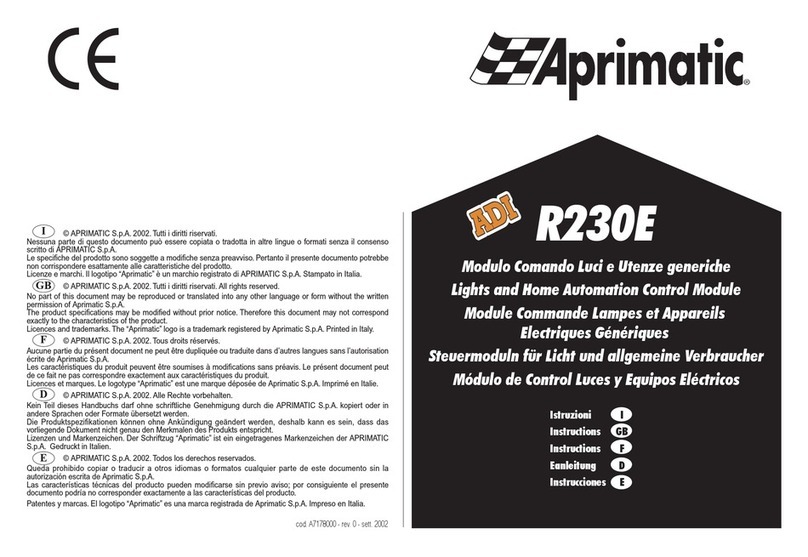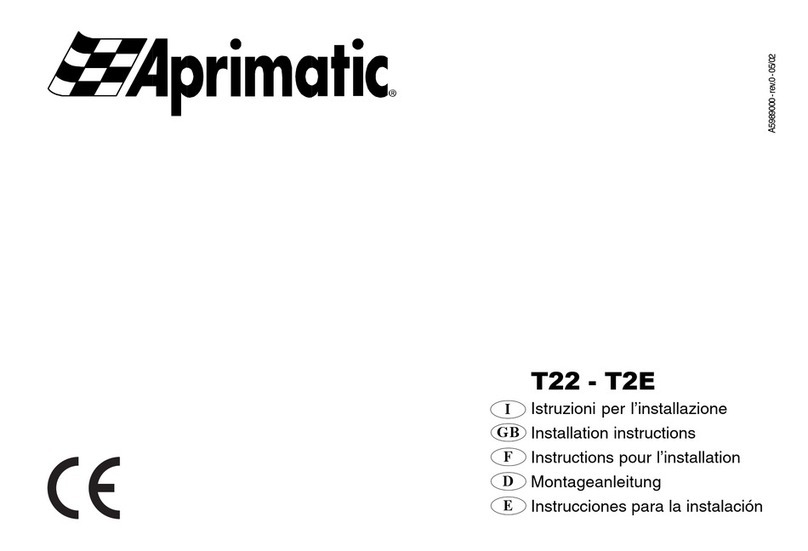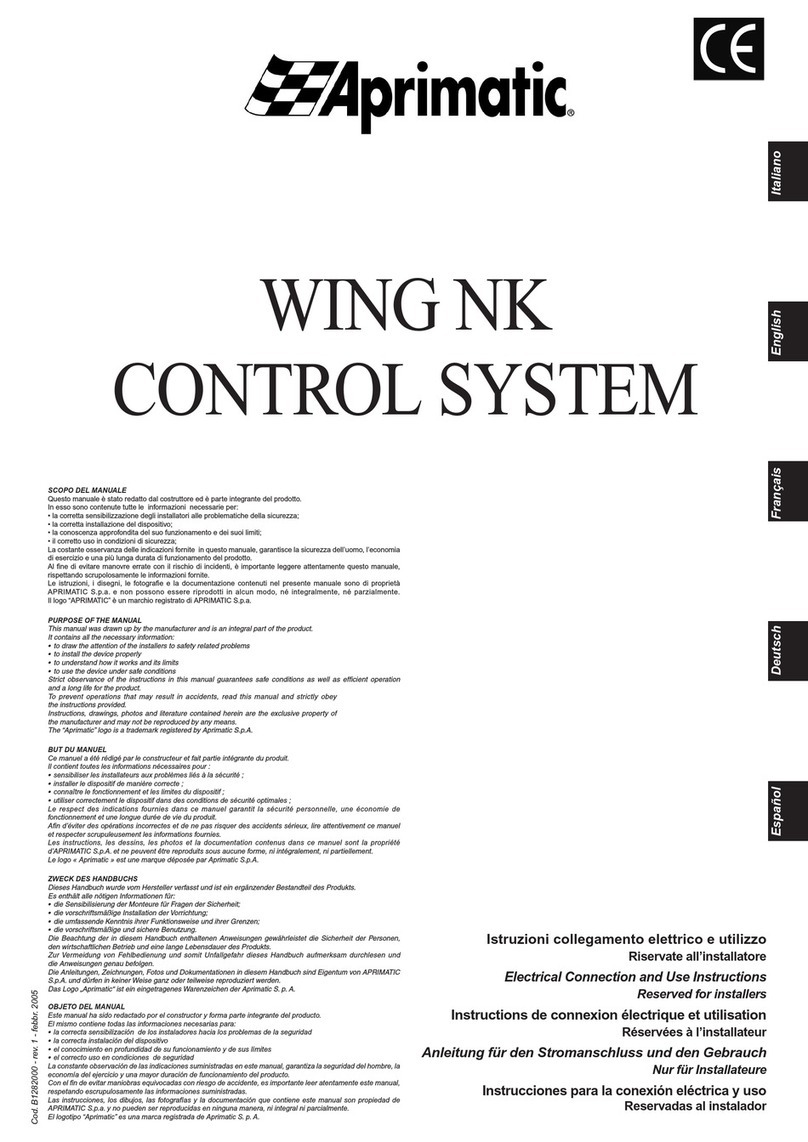
Ce manuel a été rédigé par le fabricant et fait partie intégrante du produit.
Les informations qui y sont contenues s’adressent aux opérateurs spécialisés qui effectuent les opérations de pose
et d’entretien extraordinaire. Ceux-ci doivent posséder des compétences et des qualités spécifiques pour effectuer
de façon correcte et en toute sécurité les interventions de leur compétence directe.
Le respect des indications fournies dans ce manuel garantit la sécurité personnelle, une économie de
fonctionnement et une longue durée de vie du produit.
Afin d’éviter des opérations incorrectes et de ne pas risquer des accidents sérieux, lire attentivement ce manuel
et respecter scrupuleusement les informations fournies.
Ce produit doit être installé dans des habitations résidentielles. Après en avoir effectué la pose, l’opérateur devra
vérifier l’installation correct et le bon fonctionnement.
Il devra ensuite informer l’utilisateur sur la bonne utilisation du produit et lui remettre toute la documentation
prévue par le fabricant.
Le sommaire détaillé, placé au début du manuel, permet de retrouver facilement les sujets à consulter.
BUT DU MANUEL
Este manual ha sido redactado por el constructor y forma parte integrante del producto. Las informaciones
que contiene van dirigidas a los operadores especializados encargados de las operaciones de instalación y
mantenimiento extraordinario. Dichos operadores deberán poseer la competencia específica y las capacidades
necesarias para llevar a efecto correctamente y en condiciones de seguridad las operaciones de las que están
encargados. La constante observación de las indicaciones suministradas en este manual, garantiza la seguridad
del hombre, la economía del ejercicio y una mayor duración de funcionamiento del producto.
Con el fin de evitar maniobras equivocadas con riesgo de accidente, es importante leer con atención este manual
y respetar escrupulosamente las instrucciones proporcionadas. Puesto que el producto estádestinado a la
instalación en viviendas, el operador especializado, después de realizar la instalación, tendráque comprobar
la correcta ejecución de la misma y el buen funcionamiento del producto. Luego tendráque enseñar al cliente
la forma correcta de utilización del producto, entregando toda la documentación facilitada por el constructor. El
índice descriptivo inicial permite buscar con facilidad los temas de interés.
OBJETO DEL MANUAL
Das vorliegende Handbuch wurde vom Hersteller verfaßt und ist Bestandteil des Produkts.
Die darin enthaltenen Informationen richten sich an erfahrenes Personal, das sowohl die Installation als auch
außerordentliche Wartungsarbeiten durchführt.
Dieses Personal mußüber spezifische Fähigkeiten und Kompetenzen verfügen, um die Arbeit korrekt und unter
sicheren Bedingungen durchführen zu können.
Die ständige Beachtung der Anweisungen gewährleistet Sicherheit, wirtschaftlichen Betrieb der Anlage
und eine längere Lebensdauer des Produkts. Zur Vermeidung von Fehlern, die zu Unfällen führen könnten,
mußdas vorliegende Handbuch aufmerksam durchgelesen und die darin enthaltenen Anweisungen genau
befolgt werden.
Da das Produkt im Privatwohnbereich installiert wird, mußdas erfahrene Personal nach der Installation die korrekte
Montage und den einwandfreien Betrieb überprüfen. Anschließend mußes den Benutzer in den richtigen Gebrauch
des Produkts einweisen und ihm die vom Hersteller vorgesehene Dokumentation aushändigen.
Das Inhaltsverzeichnis am Anfang des Handbuchs ermöglicht eine schnelle Ermittlung der jeweiligen Punkte.
ZWECK DES HANDBUCHS
This manual has been prepared by the manufacturer and is an integral part of the product.
The information is aimed at expert installers and those carrying out extraordinary maintenance operations.
These persons must be specifically qualified to carry out this work correctly and under the maximum safety
conditions.
Scrupulous observance of the instructions will ensure safety for man, economic running and a long product
functioning life. To avoid incorrect manoeuvres and therefore the risk of accidents, it is essential to read this
manual with care and strictly follow all the instructions given.
As this is a product to be installed in residential buildings, the expert installer, after completing installation
must verify that this has been performed correctly and that the product functions smoothly. Subsequently, it
is necessary to instruct the user on the correct use of the product providing all the documentation envisaged
by the manufacturer.
The table of contents, at the beginning, makes it easy to find the topics of interest.
PURPOSE OF THE MANUAL
AT163 AT164
Istruzioni per l’installazione
Installation instructions
Instructions pour l’installation
Installationsanleitung
Instrucciones para la instalación
Questo manuale è stato redatto dal costruttore ed è parte integrante del prodotto.
Le informazioni sono dirette agli operatori esperti che eseguono l’installazione e la manutenzione straordinaria.
Essi devono possedere competenze specifiche e particolari capacità per eseguire correttamente ed in sicurezza
gli interventi di loro competenza.
La costante osservanza delle informazioni garantisce la sicurezza dell’uomo, l’economia di esercizio ed una
più lunga durata di funzionamento del prodotto.
Al fine di evitare manovre errate con il rischio di incidenti, è importante leggere attentamente questo manuale,
rispettando scrupolosamente le informazioni fornite.
Considerando che tale prodotto va installato in abitazioni residenziali, l’operatore esperto, dopo aver effettuato
l’intervento dovrà constatarne la corretta installazione ed il regolare funzionamento.Successivamente dovrà istruire
l’utente sull’uso corretto del prodotto rilasciando tutta la documentazione prevista dal costruttore.
L’indice descrittivo, posto all’inizio, consente facilmente la rintracciabilità degli argomenti di interesse.
SCOPO DEL MANUALE
Italiano
EnglishFrançais
Deutsch
Español
Cod. A4789000 09/2001 AP031































